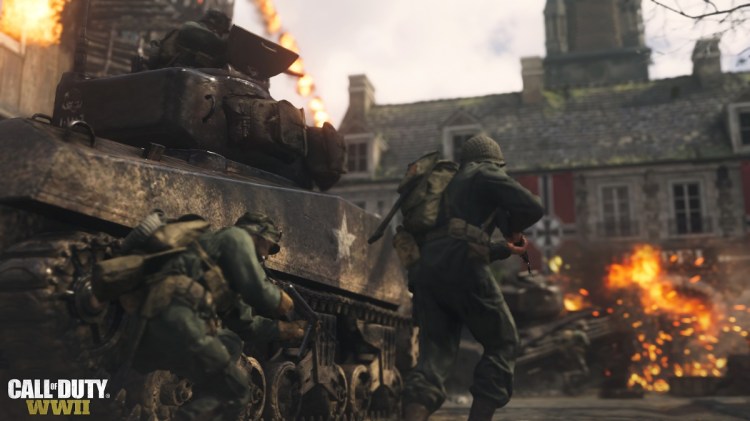Sledgehammer Games and Activision revealed Call of Duty: WWII’s multiplayer combat last week at the Electronic Entertainment Expo (E3), the influential game trade show in Los Angeles. I played a few rounds of multiplayer on some close-combat maps, and then I interviewed Michael Condrey, the cofounder of Sledgehammer Games.
It was an all-too-brief hands-on session, but I enjoyed it. We started with a battle in the bunkers at Pointe Du Hoc, where the U.S. Army Rangers scaled cliffs and fought hand-to-hand. Then we played a round of domination in the ruins of a stone building. And we also played a “war mode” map where we progressed from one task to another, such as building a bridge across a riverbed. At first, I played as a German soldier. That took me aback at first, but I soon got used to it.
With multiplayer, you’ll be able to congregate with other players in Headquarters, where you can share your accomplishments and socialize. Sledgehammer isn’t confining locations for multiplayer maps to areas where the 1st Infantry Division fought, as in the single-player campaign. You’ll fight in Normandy, Berlin, the edge of Russia, and even on Gibraltar overlooking Africa.
I didn’t fare that well, but it didn’t take me long to grasp the multiplayer and get into the action. This new Call of Duty debuts on the consoles and PC on November 3. Here’s an edited transcript of our interview.
June 5th: The AI Audit in NYC
Join us next week in NYC to engage with top executive leaders, delving into strategies for auditing AI models to ensure fairness, optimal performance, and ethical compliance across diverse organizations. Secure your attendance for this exclusive invite-only event.
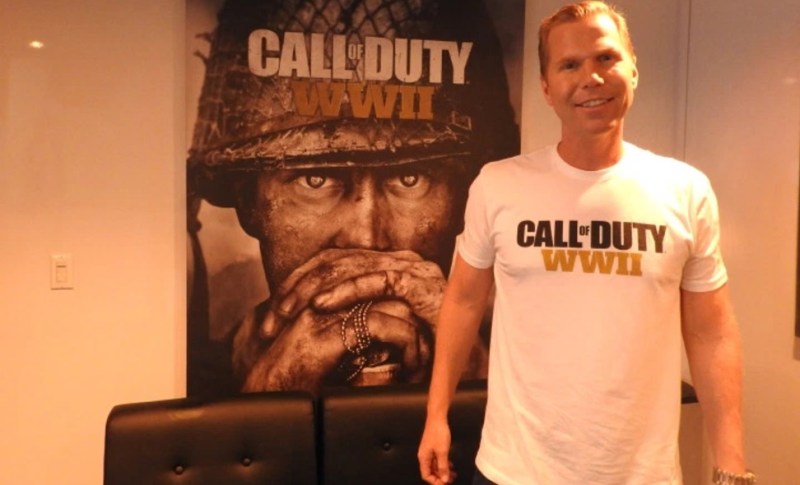
Above: Michael Condrey, co-CEO of Sledgehammer Games, maker of Call of Duty: WWII.
GamesBeat: It feels like it’s very close-quarters, at least on those maps. These arent’ big, broad sniping maps.
Michael Condrey: The approach we took on multiplayer for Call of Duty: WWII is really about reinforcing play style. Divisions, which you saw a bit of, is our replacement for create-a-class. You’re meant to enlist in a division that was iconic in WWII and then reinforce that play style. There will be maps that are really small, close maps. Pointe du Hoc, which you played, is one of those. It’s great for the Airborne and their SMGs. It’s also good for the expeditionary force with their Winchester shotgun and incendiary shells. But there are maps that are crafted to reinforce the play style of the armored division, with their LMGs, or the mountain division with snipers. You caught a bit of that in the reveal trailer with the Gustav cannon map.
We’re going to have a strong core set of maps built around that small- to medium-sized, three-lane Call of Duty map, and then some that provide a different experience. You can experiment and grow all those divisions. And of course we have War, which you played. These are all brand-new custom maps, not taken from campaign, not playable in team deathmatch, built to really drive that squad-based teamwork with a linear set of narrative-driven objectives.
GamesBeat: Building that bridge is pretty difficult. You have to be the hero and go out there and work while everyone else covers you.
Condrey: That’s a great example of what we wanted to capture, reinforcing the theme of WWII squads. In that encounter, like you say—I run the Airborne division a lot. My division gives me smoke, so I can get on the bridge, give myself some cover, and start working on building the bridge. But if there aren’t mountain and armored guys protecting me—if I have just five Airborne guys going into that objective, no way. It’s not going to happen.

Above: Winter fighting in Call of Duty: WWII.
GamesBeat: In the multiplayer, then, you get to choose beyond just your main divisions?
Condrey: Right. There are five divisions. You’ll train through those divisions and progress, which will unlock new abilities. You can switch between those at different times on the map. We want people to be able to play how they want to play and not feel like we’re constraining them to one play style. From what we saw here—we’ve pre-defined the division classes for E3, but in the beta that’s coming, the full suite of customizations will be available.
GamesBeat: So you can always level up every division?
Condrey: Exactly right. We’re trying to reinforce this theme of iconic enlistment. Through that—the infantry division begins with the M1 Garand, very iconic. It’s the only division that gets the bayonet. That’s the division weapon skill. You start out by being able to bayonet somebody, and when you progress and show proficiency in that, you get to sprint with it, then sprint even longer. There’s a learning of the skill. You also unlock some other division traits that are unique to the division. By the end, we hope players will progress through all the ranks of all divisions and maximize their play style depending on what map and mode you play in.

Above: Taking the beach bunkers in Call of Duty: WWII
GamesBeat: It seems like it’s as survivable as any other Call of Duty, depending on who you’re fighting against. I did about as well as I usually do – one kill for every two deaths.
Condrey: Bringing it back to a more grounded experience brings a certain strategy to how you play that I think people have really missed. Hopefully you saw that. Threat identification and lane identification become much more strategic, especially in the core multiplayer modes like Domination and Hardpoint. War is more about the individual sacrifice for the squad. We don’t focus on K/D in the same way. It’s more about how your team progresses to those objectives. In that core experience, the quick-to-action, run-and-gun experience, it’ll feel similar to what the series has been known for.
GamesBeat: I saw that in some levels you can call in recon and fighter support.
Condrey: We still have that suite of iconic WWII score streaks. You get to call in the P-47 strike, drop the glide bomb, use the flamethrower, drop the parachutists in as reinforcements. We have those classic Call of Duty score streak opportunities that reinforce WWII.
GamesBeat: Was I supposed to guide the fighter? All I did was pick a part of the map for it to go.
Condrey: You get to pick where you want it to go, and then you control the speed and angle of descent.
GamesBeat: I think I got shot before I finished that part.
Condrey: Yeah, you get to actually pull the trigger, aim a bit, steer and accelerate it. While you’re in it you’re immune.
GamesBeat: Does multiplayer stick to a certain set of locations? You start out in France and go on toward Germany?
Condrey: The game itself—well, multiplayer and campaign focus on the European theater of war. In multiplayer we’re in some locations that are similar to campaign. In campaign you saw the First Infantry landing on the Normandy beach. Today you played on Pointe du Hoc, which is a slightly different location. We also put you in some unique locations. We have Berlin, the edge of Russia, Gibraltar overlooking Africa. Primarily the European theater of war, but in some unique locations that you won’t see elsewhere in the game.
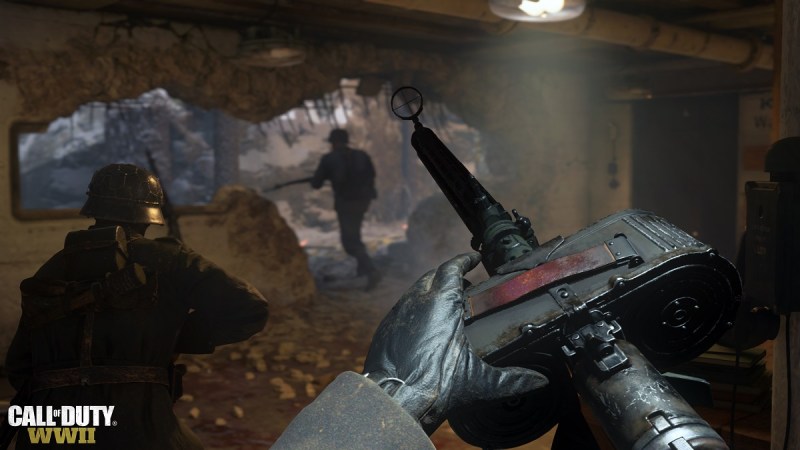
Above: Bunker warfare in Call of Duty: WWII
GamesBeat: What is it about health regeneration that’s getting people talking so much?
Condrey: With health regeneration, we took a new angle on that in the story mode, in campaign, to reinforce this idea that you’re a common man or woman fighting with a real vulnerability. You’re not a super-soldier that can regenerate your health. Instead, you have to rely on your squad, which is iconic to WWII. You need a medic. One of your squadmates needs to be with you in the campaign with a health pack for you to continue on in your mission. We’ve kept the traditional health regeneration system for multiplayer, though.
GamesBeat: You’re a little more vulnerable in single-player, then?
Condrey: It transforms how you play single-player. It makes you pause. You certainly don’t run headlong into a hail of bullets like we’ve maybe done historically. You work together as a squad. You use cover. You take your time. It feels much more authentic and believable to the setting.
GamesBeat: Can you give orders to your squad?
Condrey: You don’t command them as far as where to go, but squad abilities – tossing the health pack is one example–there’s a series of abilities that are dispersed around the squad. Different squad members can do different things. You have to be within range. They have to be alive. You have to be able to ask them to help you in that way. Depending on where you’re at in combat and who’s with you, that will change what squad abilities you have access to.
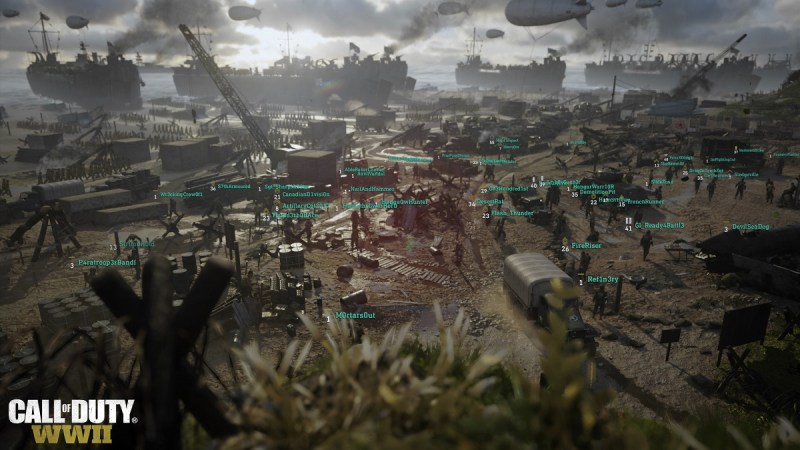
Above: Call of Duty: WWII multiplayer will let you climb a career ladder.
GamesBeat: Does this take the player back to any particular year of Call of Duty, in a sense? Has any of this happened in previous games?
Condrey: Our story—we’re calling it 1940 to 1945, but primarily it’s 1944 and 1945. We’re following a squad of the First Infantry Division, but this is a story of the Allied forces generally. You’ll work with the Royal Air Force and the French resistance and other members of the Allied forces to follow the path from Normandy, through France, the liberation of Paris, up to Belgium, the winter fighting in the Battle of the Bulge, and ultimately to the edge of Germany.
GamesBeat: Since you’ve started playtesting, what are some things you’ve learned about gameplay along the way?
Condrey: Of course, returning to boots on the ground and that strategic gameplay is something fans have reacted very positively to this week. We love that. The weapons of WWII have such an iconic signature. Bringing those back has been rewarding.
One of the great opportunities we had on this game creatively—the cause is so well-known. It’s an iconic war of good versus evil. We didn’t have to spend so much time creating a universe and getting you to believe in the protagonists and antagonists. It becomes a more personal story. It honors what really happened – a world on the edge of tyranny and chaos. That’s been rewarding. As we talk to veterans and work with our military historian and travel around to these different battle sites–the weight of being respectful has come through, I hope, in the campaign.
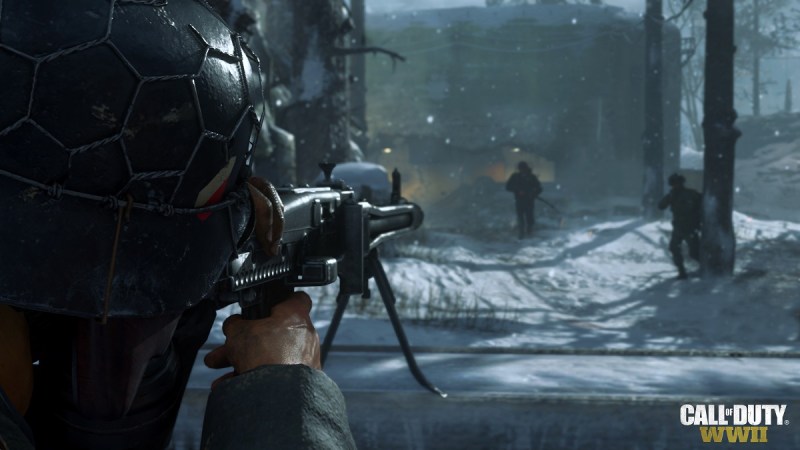
Above: Call of Duty: WWII multiplayer has traditional health regeneration.
GamesBeat: Does multiplayer communicate some of that as well? It seems like it would be a harder task there.
Condrey: I’ve talked a lot about respecting diversity of players in our games, respecting the use of the subject matter in non-gratuitous ways. This one is interesting for us. In the campaign, the thing we wrestled with and were very thoughtful about was being authentic to what happened, and respectful of the loss of life that occurred. That’s something we still talk about, up to how we include Nazi iconography, like the swastika. We want to be authentic. We also want to be respectful of a conflict where so many people died.
In multiplayer, this is about a frenetic, visceral, competitive social experience. We made different choices there. There’s no Nazi iconography in multiplayer, for several reasons. One, it’s a different experience. Two, we want all of our global fans to be able to play together without local regulations fracturing the community.
Multiplayer is a different challenge. It was important to me and to the studio to allow players to put themselves in the fantasy of enlisting in combat. As you know, we brought character customization to Call of Duty with Advanced Warfare. We felt very strongly that having players put themselves in the conflict meant that you needed to choose your own character. Whether you’re a man or a woman. Whatever nationality you want to represent yourself as. We want strong heroes in our multiplayer, and you have a variety of choices.
That does mean that when you’re placed on the Axis faction side, whatever character you choose as yourself will show up as an Axis. That’s not authentic to the conflict. That’s a choice we made intentionally and we stand behind it. While single-player is driving that authenticity and that respect, multiplayer is a different experience. And of course Zombies is a different thing altogether. It’s fantasy. We take the most creative liberties there with a crazy, scary mode.
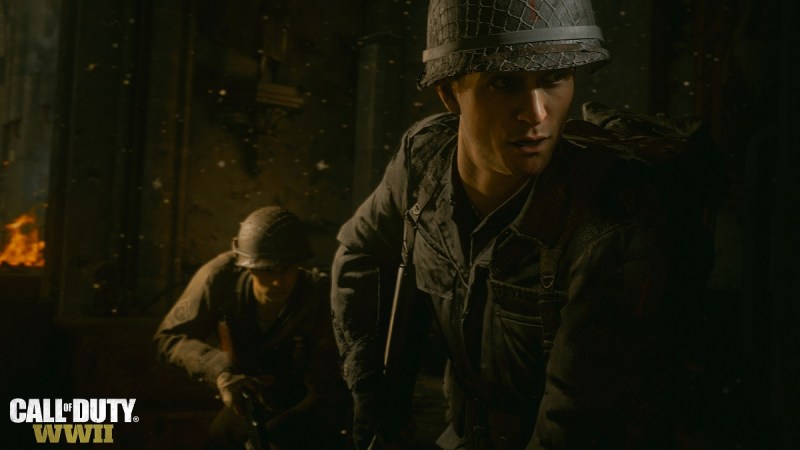
Above: Call of Duty: WWII
GamesBeat: Is there anything else we should know about?
Condrey: We’re excited about Headquarters. You didn’t see it here, but it’s the biggest innovation in multiplayer this year. It’s a franchise first, a true space where the community can come together and compete and be rewarded and show off and socialize. It’s a bit like the cities in World of Warcraft, where you come together off the front line and engage as a community in interesting ways. It’s 48 players, so a really robust community of players can come together. I’m personally very excited about it. I think it’ll transform how the community interacts.
